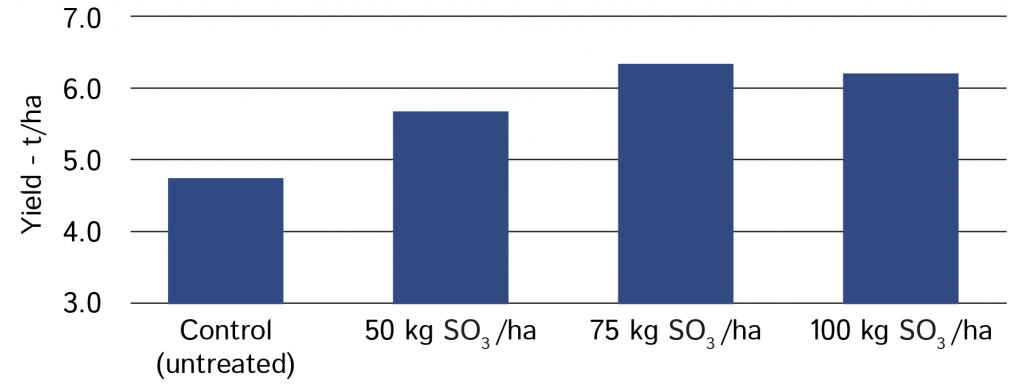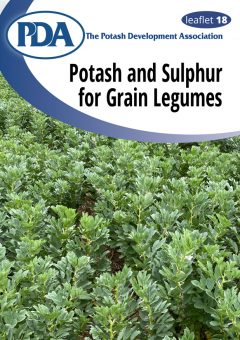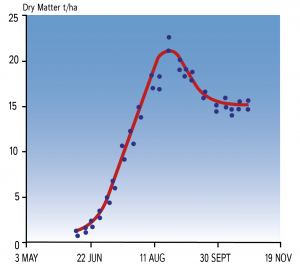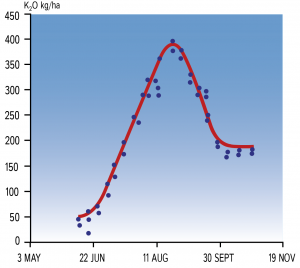18. Potash and Sulphur for Grain Legumes (2.00M)
pdf 2.00M
18. Potash and Sulphur for Grain Legumes
Published December 2020
Introduction – PGRO
Whilst there has been little recent scientific research conducted specifically in relation to pulses and potash or sulphur in the UK, a key strategic priority of the PGRO over the next 3 years is to develop crop nutrition strategies, including a focus on these nutrients.
Plant requirements for potassium are far greater than offtakes, with the majority returning to the soil in the straw. However, this means that growth and productivity can be seriously limited by sub optimal availability. Sufficient water soluble and exchangeable potassium to meet peak uptake needs to be considered and this will depend heavily upon soil type, with lighter sandier soils being most susceptible to deficiency.
Whilst elemental sulphur is well known for its properties in combatting fungal diseases, for many years it was assumed that nutritional sulphate requirements were naturally available from the environment. With cleaner air resulting in significantly reduced deposition this is no longer considered the case and instances of deficiency in fields are not uncommon.
Whilst small plot trials using sulphur applications struggle to show significant yield benefits due to soil variability, small scale and high coefficients of variation, there is an undeniable logic to the fact that since all proteins contain sulphur, yield of protein will be limited if sulphur is not in adequate supply, an especially poignant logic for protein crops – pulses such as peas and beans.
Since 2017 PGRO has been involved with the Pea, and latterly Bean, YEN (Yield Enhancement Network) with the aim of supporting growers to take the next step towards achieving their yield potential and optimal crop performance. The YENs are farmer-to-farmer benchmarking exercises designed for the sharing of knowledge, and stimulating growers to measure what they are doing against others.
With knowledge and new ideas gained, the aim is for growers to improve their own production and to produce higher performing crops and economic output. In 2019, potential pulse grain yields in the UK generally exceeded 7 t/ha for peas, 13 t/ha for spring beans and 14 t/ha for winter beans.
PGRO hopes that through the YEN project a greater understanding of pulse crops grown in commercial situations can be gained to help move the agronomy of the crop forward on farm.
Grain legumes in the UK
About 12,000 species of higher plants are known living in symbiosis with N-fixing bacteria, of which nearly 200 are legumes cultivated as crop plants in agriculture and horticulture. Field beans and peas are the main grain legume crops in the UK with, between them, around 250,000 ha grown. In recent years increasing areas of lupins, broad beans, soya beans and navy beans have all been grown. Field beans (including tick beans and horse beans) and broad beans are all sub-species of Vicia faba. Navy beans are a different species, Phaseolus vulgaris.
The nitrogen fixed by the root nodules of leguminous plants is of significant economic importance, and as such should demand greater attention. It has been reported that abundant supplies of phosphate and potash to field beans, lupins and soya beans had a beneficial effect on the nitrogen fixation by Rhizobium. Average yields of beans, peas and lupins in the UK are 3.5 – 4.0 t/ha but potential yields are much higher. These crops will repay attention to husbandry generally and to nutrition in particular.
Legumes need a good K-start!
Potassium is an essential nutrient for legumes, as it is for all other crops. It is an activator for many enzymes, especially those involved in protein synthesis. Potassium also has an important role in maintaining water balance in the plant. In legumes, potassium is necessary for the proper development and functioning of root nodules. Rhizobia bacteria in the nodules fix atmospheric nitrogen and make it available to the legume plant. If nitrogen fixation is affected by potassium deficiency, the legume will suffer a nitrogen shortage and reduced yield.
The table below shows the impact of low potassium supply on the nodulation of legume plants (broad beans). Increasing K supply had a beneficial impact on both the number and size of the root nodules. The efficiency of these nodules, the level of nitrogen fixation, also increased with increasing K application. Considering the value of nitrogen fixed by their root nodules, it is important to ensure an adequate potassium supply in order to optimise nitrogen fixation and ultimately crop yield in legumes.
| Potash supply | |||
| Low K | Medium K | High K | |
| No. of nodules/plant | 233 | 250 | 251 |
| Size of nodules, % | 100 | 111 | 129 |
| Nodule N production, % | 100 | 147 | 195 |
| The influence of potassium on the activity of Rhizobium bacteria. Proc. 11th Int. Colloquium, IPI. | |||
Deficiency symptoms
Serious potassium deficiency causes yellowing or scorching of leaf margins, forward curled leaves and, in beans, shortening of internodes (stem between leaves). As potassium is involved in nitrogen fixation in the root nodules, deficiency can also appear as an apparent nitrogen shortage, with stunted plants. Where there are visible symptoms of potassium deficiency, crop yield will have been significantly affected – less severe deficiency, which still affects yield, will not be visible. It is important therefore to ensure a good potassium supply and to avoid the occurrence of deficiencies. Concentrations in pea and bean leaf tissue of 1.1 – 1.2% K in dry-matter have been associated with optimum potassium nutrition.
Potassium uptake and removal by legumes
Beans are quite deeply rooted but peas have a much less extensive root system. It is important that the topsoil is well supplied with potassium to support uptake by peas.
Legumes can take up very large amounts of potassium as shown by work in France on white lupins. By late August at peak canopy, the crop had produced more than 20 t/ha dry-matter and had taken up around 400 kg K2O/ha. The grain yield of 3.3 t/ha removed 45 kg K2O/ha.
Combined peas remove around 10 kg K2O per tonne of dry peas (fresh weight) and beans and lupins remove around 12 kg K2O/t of dry seed. Removal for a 4 t/ha crop will be around 40 kg K2O/ha for peas and 48 kg/ha for beans and lupins.
Yield response to potassium
In field trials at Rothamsted on silty clay loam soils, field beans responded up to around 200 mg/l soil K (upper soil index 2).
Experiments on a sandy clay loam soil at two levels of soil potassium examined the response of wheat and field beans to two rates of fertiliser potash. Wheat yields were not affected by the level of soil potassium in the trial and gave no response to added fertiliser. Beans however yielded much less on the lower potassium soil even though the addition of fertiliser potash gave a large yield increase. The best bean yield was on the higher potassium soil.
| Soil K level (mg/kg) | 110 | 170 | ||
| Potash applied (kg/ha) | 0 | 53 | 0 | 53 |
| Wheat yield (t/ha) | 8.5 | 8.5 | 8.5 | 8.6 |
| Field beans yield (t/ha) | 2.5 | 3.6 | 4.4 | 4.4 |
| Rothamsted Research – Saxmundham data. | ||||
Fertiliser policy and recommendations
Best yields are likely to be obtained where an adequate level of soil potassium (around 180 mg/l or top of index 2-) is supported by maintenance application (M) of fertiliser potash. The rate of fertiliser potash application should be adjusted to take into account both soil index and the realistic yield for the field. Recommendations below are for a pea yield of 4 t/ha or a bean/lupin yield of 3.5 t/ha at a range of soil K indices:
| Soil K Index | 0 | 1 | 2- | 2+ | 3 or above |
| Soil K (mg/l) | 0-60 | 61-120 | 121-180 | 181-240 | 241+ |
| Potash recommendation (kg K2O/ha) | 100 | 70 | 40(M) | 20 | 0 |
Recommendations should be adjusted if the yield is expected to be different, using the removal figures given:
| Removal of potash per tonne of grain fresh weight (kg K2O/t) |
|
| Dry peas | 10.0 |
| Field beans | 12.0 |
| Lupins | 12.0 |
Timing of fertiliser application
Usually, potash will be applied to the seedbed in a PK fertiliser. Where large amounts of fertiliser potash are needed to improve low soil fertility, the potash should be broadcast and worked well into the seedbed. For spring sown crops, some of the potash can be applied in the autumn. To avoid risk of damage to germinating seedlings, no more than 50 kg K2O/ha should be added at drilling.
Phosphate for Legumes
Legumes can require significant amounts of phosphate due to the role this nutrient plays in root development, nutrient uptake and growth. Furthermore, as phosphate is a vital component of the ‘energy compounds’ within a plant; and as the fixation of atmospheric nitrogen is an energy hungry process; its efficiency is heavily reliant on plants having access to sufficient levels of phosphate.
In grain legumes, phosphate enhances nodulation and nodule growth, as can be seen in the table and graph below.
| Nodules per plant | Nodule weight | |
| Control | 7.69 | 94.44 |
| 20 kg/ha P2O5 | 8.47 | 95.21 |
| 40 kg/ha P2O5 | 10.02 | 101.77 |
| 60 kg/ha P2O5 | 10.36 | 102.9 |
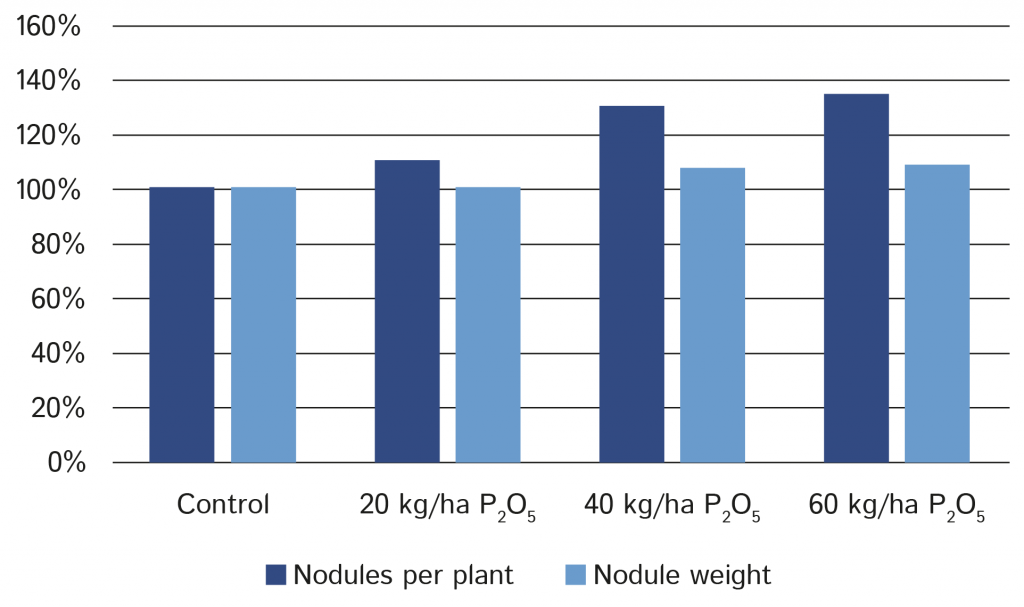
Sulphur for Legumes
Sulphur is an essential plant nutrient as a constituent of several amino acids which are essential for protein production. Sulphur deficiency decreases plant growth, photosynthesis, and seed yield. In nodulated legumes, sulphur supply is linked to nitrogen fixation and deficiency results in reduced nodulation, inhibition of nitrogen fixation, and a slowing down of nodule metabolism.
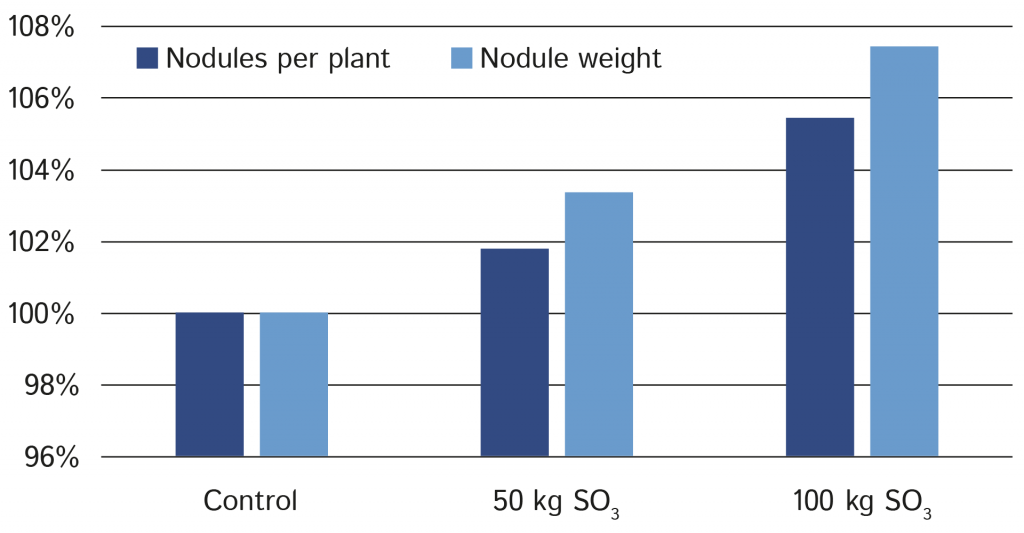
Recent trial work carried out by the PGRO looking at sulphur applications to vining peas has shown a positive trend of increased yields from increasing the sulphur supply through applications of Polysulphate™. The yield increases indicated an optimum rate of approximately 75 kg SO3/ha.
